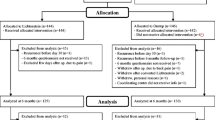Abstract
Background
Morbidity associated with open inguinal hernia repair (IH repair) mainly consists of chronic pain. The aim of this study was to identify possible disparities between state-of-the-art Lichtenstein repair, and its application in general practice.
Methods
A questionnaire was mailed to all surgeons and surgical residents (n = 1,374) in the Netherlands in February 2005. The objective was to determine the state of general practice with respect to technical steps during the Lichtenstein repair that are suggested to be involved in the development of chronic pain, as recently updated by Lichtenstein’s successor, Amid.
Results
More than half of the respondents do not act according to the Lichtenstein guidelines with respect to surgical steps that are suggested to be involved with the origin of chronic pain of somatic origin. Compliance with Amid’s guidelines with respect to the handling of the nerves is variable. Surgeons conducting high numbers of IH repair are more likely to operate according to the key principles of the state-of-the-art Lichtenstein repair.
Conclusion
There is a substantial disparity between the state-of-the-art Lichtenstein repair and its application in general practice with respect to steps that are suggested to play a role in the origin of chronic groin pain.
Similar content being viewed by others
References
Cunningham J, Temple WJ, Mitchell P, Nixon JA, Preshaw RM, Hagen NA (1996) Cooperative hernia study. Pain in the postrepair patient. Ann Surg 224:598–602
Poobalan AS, Bruce J, King PM, Chambers WA, Krukowski ZH, Smith WC (2001) Chronic pain and quality of life following open inguinal hernia repair. Br J Surg 88:1122–1126
Poobalan AS, Bruce J, Smith WC, King PM, Krukowski ZH, Chambers WA (2003) A review of chronic pain after inguinal herniorrhaphy. Clin J Pain 19:48–54
Lichtenstein IL, Shulman AG, Amid PK, Montllor MM (1988) Cause and prevention of postherniorrhaphy neuralgia: a proposed protocol for treatment. Am J Surg 155:786–790
Amid PK (2004) Lichtenstein tension-free hernioplasty: its inception, evolution, and principles. Hernia 8:1–7
Neumayer L, Giobbie-Hurder A, Jonasson O, Fitzgibbons R Jr, Dunlop D, Gibbs J, Reda D, Henderson W (2004) Open mesh versus laparoscopic mesh repair of inguinal hernia. N Engl J Med 350:1819–1827
Bay-Nielsen M, Nilsson E, Nordin P, Kehlet H (2004) Chronic pain after open mesh and sutured repair of indirect inguinal hernia in young males. Br J Surg 91:1372
Koninger J, Redecke J, Butters M (2004) Chronic pain after hernia repair: a randomized trial comparing Shouldice, Lichtenstein and TAPP. Langenbecks Arch Surg 389(5):361–365
Amid PK, Shulman AG, Lichtenstein IL (1993) Critical scrutiny of the open “tension-free” hernioplasty. Am J Surg 165:369–371
Kehlet H, Jensen TS, Woolf CJ (2006) Persistent postsurgical pain: risk factors and prevention. Lancet 367:1618–1625
Alfieri S, Rotondi F, Di Giorgio A, Fumagalli U, Salzano A, Di Miceli D, Ridolfini MP, Sgagari A, Doglietto G (2006) Influence of preservation versus division of ilioinguinal, iliohypogastric, and genital nerves during open mesh herniorrhaphy: prospective multicentric study of chronic pain. Ann Surg 243:553–558
Lik-Man Mui W, Ng CS, Ming-Kit Fung T, Ka Yin Cheung F, Wong CM, Ma TH, Bn MY, Kwok-Wai Ng E (2006) Prophylactic ilioinguinal neurectomy in open inguinal hernia repair: a double-blind randomized controlled trial. Ann Surg 244:27–33
Simons MP, Hoitsma HF, Mullan FJ (1995) Primary inguinal hernia repair in the Netherlands. Eur J Surg 161:345–348
Ravindran R, Bruce J, Debnath D, Poobalan A, King PM (2006) A United Kingdom survey of surgical technique and handling practice of inguinal canal structures during hernia surgery. Surgery 139:523–526
Author information
Authors and Affiliations
Corresponding author
Rights and permissions
About this article
Cite this article
Wijsmuller, A.R., Lange, J.F.M., van Geldere, D. et al. Surgical techniques preventing chronic pain after Lichtenstein hernia repair: state-of-the-art vs daily practice in the Netherlands. Hernia 11, 147–151 (2007). https://doi.org/10.1007/s10029-006-0177-0
Received:
Accepted:
Published:
Issue Date:
DOI: https://doi.org/10.1007/s10029-006-0177-0




